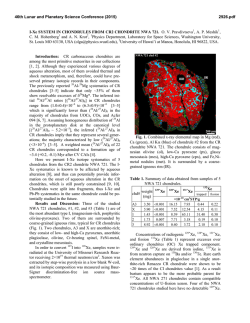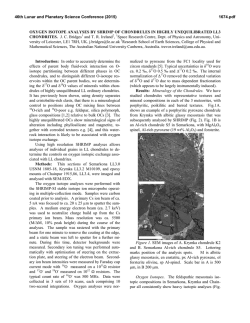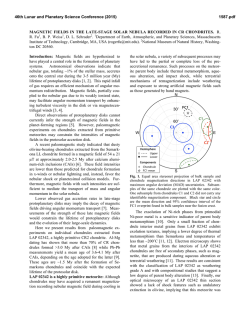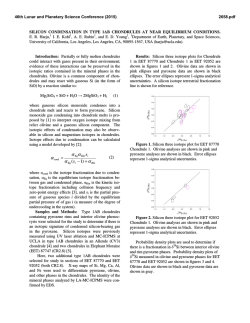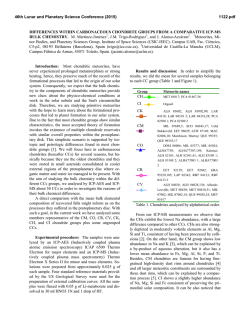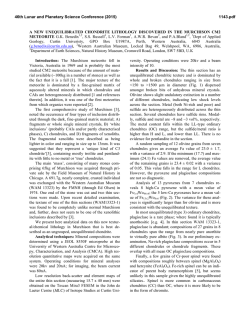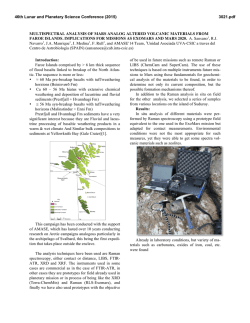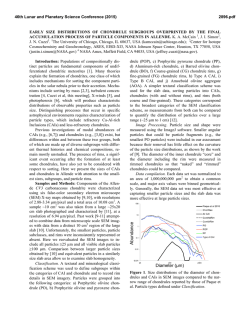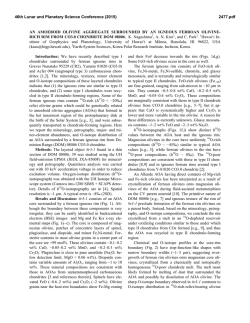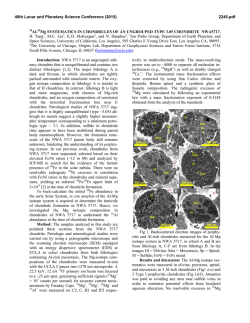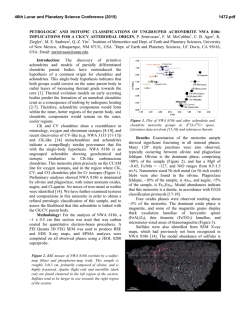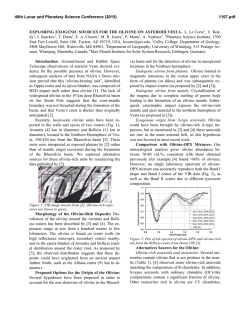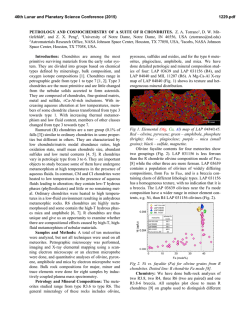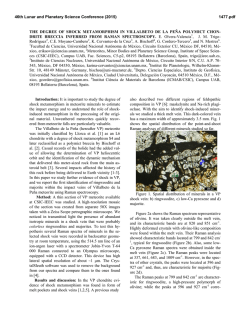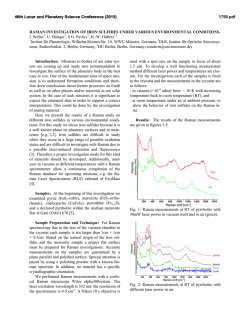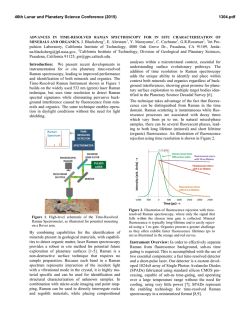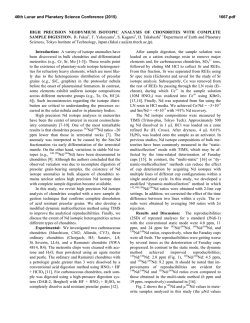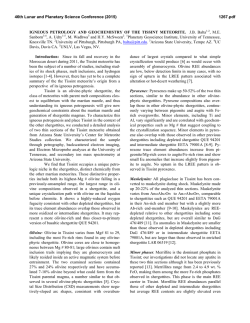
Identification of a Silico-Phosphate in CK4 Carbonaceous Chondrite
46th Lunar and Planetary Science Conference (2015) 1785.pdf IDENTIFICATION OF A SILICO-PHOSPHATE IN CK4 CARBONACEOUS CHONDRITE ALLAN HILLS 85002. M. Urzaiz1, J.M. Trigo-Rodríguez1, and N. Mestres2. 1Meteorites, Minor Bodies and Planetary Sciences Group, Institute of Space Sciences (CSIC-IEEC). Campus UAB, Fac. Sciences, C5-p2, 08193 Bellaterra (Barcelona), Spain. [email protected] 2 Institut Ciència de Materials de Barcelona (ICMAB/CSIC), Campus UAB, 08193 Bellaterra (Barcelona), Spain. Introduction: Collisional processing is expected to be an important process for primitive undifferentiated asteroids along the eons [1-6]. Despite of this, direct evidence of shock in carbonaceous chondrites remains elusive and not so well characterized as for ordinary chondrites [6]. A significant number of chondritic meteorites have been found to be breccias exhibiting unequivocal features of shock metamorphism [4-7]. Obviously, shock is accompanied by brecciation due to the transport of comminuted rock fragments often available at the surfaces of asteroids. Small NEAs probably have intense collisional histories due to the cascade sequence of events occurring during their dynamic transport until they reach the near-Earth region. We briefly described some mineralogical and petrological features of CK chondrites that support the relevance of collisional processing in their evolutionary histories [8]. A case example is ALH 85002 that contains fractured chondrules, abundant opaques, a equilibrated matrix and CAIs. These components are well defined texturally. There is little evidence of terrestrial aqueous alteration. Some chondrules exhibit complex chemical zoning. Matrix is about 30 vol% that is similar to other CR chondrites [9]) and clastic in texture. Technical procedure: One thin section of ALH 82005 was studied. High-resolution mosaics of the sections were created from separate 50X images taken with a Zeiss Scope petrographic microscope. The mosaic allowed us to establish target features to be characterized by micro-Raman. Future studies will involve SEM+EDS and microprobe techniques. In the thin section mosaic we selected several fractured chondrules in order to find clues of shock in its mineralogy. One of them, labelled as L3 (Fig. 1), is described here in detail. Micro-Raman study. Several micro-Raman spectra were taken in backscattering geometry at room temperature using 5145 Å line of Argon-ion laser with a Jobin-Yvon T-64000 Raman spectrometer attached to an Olympus microscope and equipped with a liquidnitrogen-cooled CCD detector. The Raman points are marked in red in Figure 1. Their lateral spatial resolution was ~1μm and the laser power onto the sample was kept below 0.5 mW to avoid degradation due to sample overheating. The Raman spectrometer provided spectra in a working range between 100 and 1,300 cm-1 Results and discussion: ALH 85002 matrix is rich in opaques, mostly magnetite and sulfides. Some olivine chondrules show signs of plastic deformation exhibiting substantial textural integration with the surrounding metal and matrix. Porous melt veins containing angular olivine fragments and abundant, rounded, micron-sized magnetite grains. We have confirmed this mineralogy by point-and-shoot Raman analyses. The different points studied in the labelled L3 chondrule (see the thin section mosaic+grid in Fig. 2) have the double peak of olivine without clear compositional differences (see Fig. 3, spectra A-C). The dark veins are filled with magnetite that exhibits the characteristic peak at 676 cm-1. In the chondrule border we have temptatively identified merrillite (Fig. 3, spectrum I). Figure 1. Studied olivine chondrule in ALH 85002. Conclusions: Several olivine chondrules of ALH 82005 were studied to get evidence of shock-induced features. Our Raman analyses have not clearly identified shocked minerals, but perhaps some merrillite in the chondrule borders. That border also has a mineral that we temptatively identify as variety of perhamite (see Fig. 3, spectrum I) a silico-phosphate with characteristic peaks at 639, 1110, 1140 and 1185 cm-1 [10]. The presence of merrillite and perhamite in the border of chondrules could be indicative of compaction that perhaps promoted aqueous alteration. Shock compaction is preferently induced in the border of large tough materials like chondrule or inclusions in the simple piston model envisioned for CM chondrites [11]. The recently proposed link between CV and CK groups [12] might be explained by different degrees of collisional and aqueous processing of different asteroid fragments. 46th Lunar and Planetary Science Conference (2015) 1785.pdf Acknowledgements: We acknowledge support from the Spanish Ministry (project AYA2011-26522). Figure 2. TL mosaic of the analyzed section showing the chondritic texture and the presence of opaques. References: [1] Blum J. et al. (2006) Ap.J. 652, 1768. [2] Trigo-Rodríguez J. M. and J. Blum (2009) Plan. Space Sci. 57, 243. [3] Rubin A.E. et al. (2002) Meteorit. Planet. Sci. 37, 125. [4] Bischoff A. et al. (2006) in Meteorites and the Early Solar System II, D.S. Lauretta & H.Y. McSween Jr. (eds.), Univ. Arizona Press, Tucson, 679-712. [5] Bischoff A. & Stöffler D. (1992) Eur. J. Mineral. 4, 707-755. [6] Stöffler D. et al. (1991) Geochim. Cosmochim. Acta 55, 3845– 3867. [7] Bischoff A. et al. (2013) Meteorit. Planet. Sci. 48, A61. [8] Urzaiz M. et al. (2014) 77th MetSoc, LPI Contribution No. 1800, id.5060. [9] Weisberg M. K. et al. 1993. GCA 57: 1567-1586. [10] Frost R.L. et al. (2007) Spectrochim. Acta Part A 67, 604. [11] Trigo-Rodríguez J.M. et al. (2006) Geochim. Cosmochim. Acta 70, 1271. [12] Wasson J.T. et al. 2013. Geoch. Cosmoch. Acta 108: 45-62. Figure 3. Raman spectra of A, B, E, and I points marked in Fig. 1.
© Copyright 2026
